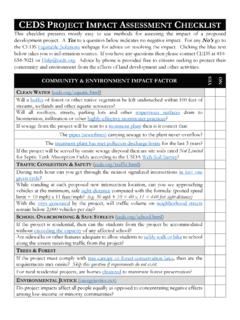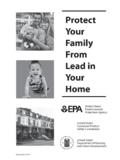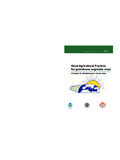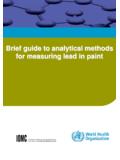Transcription of 4 Methods used for health risk assessment - who.int
1 4 Methods used for health risk assessment1234 Methods used for health risk assessmentC. Thoeye1,K. Van Eyck2, Davide Bixio1, M. Weemaes and G. De Gueldre1 Aquafin NV, Dijkstraat 8, 2630 Aartselaar, Belgium SVW vzw Samenwerking Vlaams Water, Mechelsesteenweg 64, 2018 Antwerp, chapter looks first at the existing legislation concerning drinking-water production, to illustratethe risks related to the use of wastewater as a drinking-water source. It then considers the maincontaminants of concern in the practice of aquifer recharge and abstraction for chapter also describes in detail the two main approaches to health risk assessment . The firstof these is the parameter approach, in which the estimation of the risk related to the use of water isbased upon the presence of different parameters ( chemicals and microorganisms).
2 Everyparameter is considered separately and its concentration is compared with a reference parameter approach is based on either: water-quality standards where the reference concentration is the one given by thedrinking-water quality standards; or quantitative risk assessment where toxicological data, and data on infectious doses andacceptable risk (chemical and biological) are taken as a case study of quantitative health risk assessment in domestic water reuse is provided, toillustrate the practical application of this approach. This is followed by a detailed description of themain types of modelling technique used in risk , this chapter describes the approach of studying the effect of the water on test organismsor on the population.
3 This effects approach can involve using biological tests to look at how awater affects test organisms, cells or tissues, or epidemiological studies to examine the effects on ahuman Legislation applying to groundwater, spring water and surface waterThe main aim of legislation concerning drinking-water is to minimize the risks for water users. Theproduction of drinking-water from groundwater or spring water is subject to very few regulations,because of the low risk to public health . The produced water must comply with the drinking-waterstandards, and many countries also have regulations on protection of drinking-water sources and onaquifers used for drinking-water of drinking-water from surface water is covered by more complex regulations,because of the higher health risk.
4 Apart from the application of the drinking-water standards,regulations exist on the water source and on the minimal treatment to be applied to the surfacewater. An example is the European Community directive concerning production of drinking-waterfrom surface water (Commission of the European Communities, 1975). The directive dividessurface water sources suitable for drinking-water production into three classes, depending on theirquality, which is assessed on the basis of 46 parameters and their concentrations. It also defines aminimal treatment, as a function of the quality. Production of drinking-water from good qualitysurface water (category A) requires only physical treatment ( rapid filtration) and from more polluted water (categories B and C) requires more sophisticated treatment4 Methods used for health risk assessment124such as break-point chlorination , coagulation, flocculation, filtration, active carbon treatment Legislation applying to recycled waterVery few countries intentionally produce drinking-water from recycled wastewater, and therefore,until now, no generally accepted reuse standards have been set.
5 However, some interesting pointsconcerning reuse legislation are described is logical that drinking-water produced from an aquifer containing recharged treated effluentshould comply with the drinking-water standards. However, because effluent may contain a widerange of pollutants, an increased health risk can be expected in drinking-water from this source. Todeal with the extra risk, the Californian Administrative Code, Title 22 (Wastewater reclamationcriteria) sets standards on a list of chemicals that are not covered by the drinking-water standards,but that have an increased chance of being found in recycled water (State of California, 1978).
6 Drinking-water production from recycled wastewater almost always includes passage of the waterthrough soil. The main reasons for passing the water through soil, which is considered a polishing step, are to: remineralize the water create a lag time between infiltration and abstraction remove certain recognition of the beneficial effects of soil passage, some regulations cover minimal soilpassage conditions. An example of minimal aquifer treatment for reuse is given by the Californianlegislation described above. Infiltration is allowed providing that a permit has been issued. Thepermit is for surface spreading at a given percolation rate (< to < cm/min), and specifies: the minimum retention time (6 12 months); the maximum percentage of recycled water in the extracted well water (20 50%); the horizontal separation between the recharge site and the abstraction well (165 330 m); the minimum depth to the groundwater ( m)The actual values depend on the soil type and are fixed on a case-by-case from the United States Environmental Protection Agency (US EPA) and theCalifornian Title 22 both specify the minimal treatment that wastewater must undergo beforeaquifer infiltration.
7 Also, both require the use of advanced wastewater treatment processes such aschemical clarification, carbon adsorption, reverse osmosis and other membrane processes, airstripping, ultrafiltration and ion countries where excessive groundwater extraction threatens to dry out aqufiers, the use ofinfiltration of treated surface water is increasing. These countries have set standards on the water tobe infiltrated, to protect aquifers and avoid the infiltration of hazardous components. Usually, thestandards are developed for infiltration of treated surface water rather than for treated wastewater(Nederlands Staatsblad, 1993).
8 Countries that allow infiltration of treated wastewater regulate thepractice by permits, which are allocated case-by-case and granted for a limited time. Infiltrationstandards are set as a part of the Drinking-water standards relevant to aquifer recharge and abstractionDrinking-water standards are country specific and are generally based on the WHO Guidelines forDrinking-water Quality (WHO, 1996). The WHO guidelines are currently being revised, with4 Methods used for health risk assessment125publication expected in 2004. The European Community drinking-water directive 98/83/EC(Commission of the European Communities, 1998), based on the WHO guidelines, gives theminimal requirements with which the national standards of member states must standards are regularly adapted, to keep up with the latest information onnegative effects of chemicals on health .
9 Substances for which there is new evidence of harmfulnessbut no conclusions about the detrimental effect on human health are put on priority pollutant lists form the basis for research and for review of drinking-water standards. An example of apriority pollutant list is the US EPA Drinking water Contaminant Candidate List (CCL). A largenumber of the pollutants on priority lists are found in domestic , revisions of drinking-water standards result in an increase of the number of parametersincluded. However, in the most recent revision of the Belgian drinking-water standards, the numberof parameters decreased, although at the same time the new regulations specify that the watersupplier has to carry out analyses on the chemicals and microorganisms not covered by thestandards but that can be present in the water and that can pose a risk to public health (FlemishGovernment, 2002).
10 These revised water quality standards are less useful as a reference for healthrisk assessment in relation to approach to controlling the presence of pathogens in drinking-water is changing. Classically,the microbial quality of water is assessed using microbial indicators. However, such indicators donot represent all pathogenic organisms, and faster and cheaper Methods for analysis ofmicroorganisms are becoming available, so that certain drinking-water standards now includepathogenic microorganisms. For example, the US EPA drinking-water standards contain regulationsfor Cryptosporidium, Giardia, Legionella and enteric viruses.

















